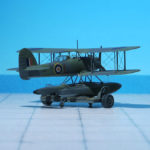TYPE: Reconnaissance floatplane
ACCOMMODATION: Crew of two
POWER PLANT: One Napier Rapier air-cooled engine, rated at 395 hp
PERFORMANCE: 124 mph
COMMENT: The Fairey Seafox was a 1930s British reconnaissance floatplane designed and built by Fairey for the Royal Fleet Air Arm. It was designed to be catapulted from the deck of a light cruiser and served in the WW II. Of the 66 built, two were finished as landplanes.
The Fairey Seafox was built to satisfy Air Ministry Specifications S.11/32. The first of two prototypes appeared in 1936, first flying on May 1936, and the first of the 64 production aircraft were delivered in 1937. The flights were organized as 700 Naval Air Squadron of the Fleet Air Arm.
The fuselage was of all-metal monocoque construction, the wings being covered with metal on the leading edge, otherwise fabric. It was powered by a 16-cylinder 395 hp air-cooled Napier Rapier H engine. It cruised at 106 mph, and had a range of 440 mi.
Although the Seafox handled well, it was criticized for being underpowered, engine cooling was poor and landing speeds were higher than desired.
In 1939, a Seafox played a part in the Battle of River Plate against the German pocket battleship “Admiral Graf Spee”, by spotting for the naval gunners. This ended with “Graf Spee’s” scuttling and destruction.
Seafoxes operated during the early part of the war from the cruisers HMS “Emerald”. “Neptune”, “Orion”, “Ajax”, “Arethusa” and “Penelope” and the armed merchant cruisers HMS “Pretoria Castle”, “Asturias” and “Alcantara”. The floatplanes remained in service until 1943 (Ref.: 24).












